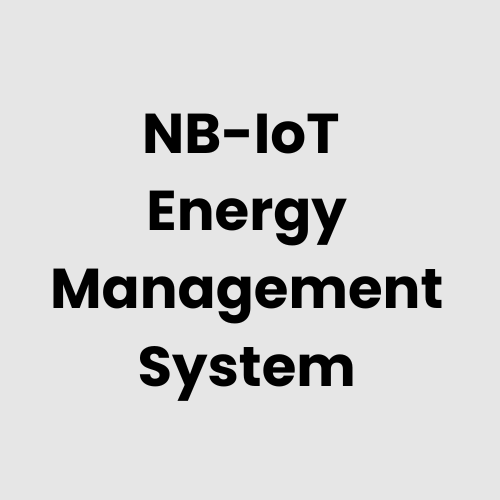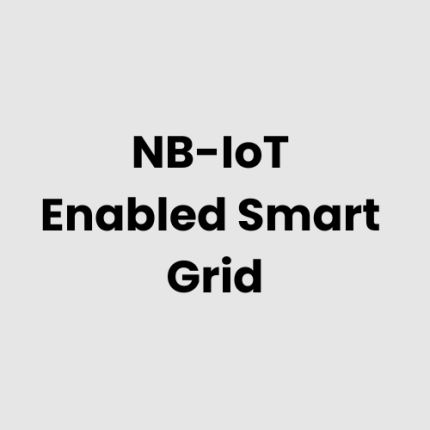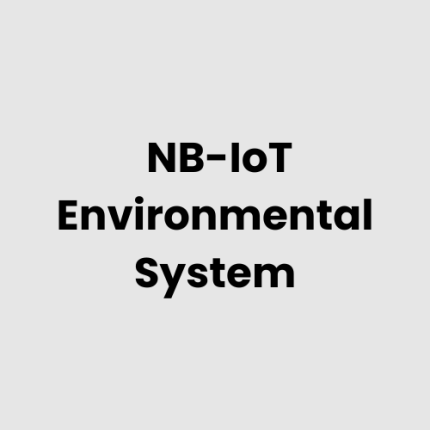Description
Technical Architecture
The NB-IoT Enabled Energy Management System by GAO Tek is designed to optimize energy usage and provide real-time monitoring of energy consumption across various applications. The system architecture includes several components that interact to collect, transmit, analyze, and manage energy data efficiently:
- Energy Meters and Sensors:
Smart energy meters and sensors are deployed at key points within the energy infrastructure to monitor parameters such as voltage, current, power factor, and consumption rates. - NB-IoT Connectivity Layer:
The system utilizes NB-IoT technology to ensure reliable and long-range communication between energy meters and the central platform. NB-IoT’s low-power, wide-area network (LPWAN) is ideal for remote or inaccessible locations. - Data Aggregation and Gateway Devices:
These devices collect data from the energy meters and transmit it to a central server or cloud platform for further processing and analysis. They can be deployed in areas where network access is limited or infrastructure needs to be expanded. - Edge Computing (Optional):
In certain cases, edge devices can process the data locally to ensure real-time decision-making. This reduces latency and the need for constant communication with the central platform. - Centralized Data Management Platform:
This platform processes, stores, and analyzes data gathered from all energy meters. It provides energy managers with insights into usage trends, peak demand, and opportunities for optimization. - Analytics and Reporting Tools:
Data analysis tools offer visualization, predictive analytics, and reporting features to help optimize energy consumption, forecast demand, and identify inefficiencies. - User Interface:
The system includes a web or mobile interface that allows energy managers to monitor energy usage, configure devices, and receive alerts or notifications.
List of Hardware for NB-IoT Enabled Energy Management System
- Smart Energy Meters: Devices that measure electricity consumption in real time.
- Current/Voltage Sensors: Sensors that detect changes in voltage, current, and other electrical parameters.
- NB-IoT Communication Modules: Modules to enable data transmission from energy meters to the central platform.
- Gateways: Devices that collect data from multiple meters and transmit it to the central server or cloud.
- Edge Computing Devices: Optional local processors for data analysis and decision-making.
- Power Supply Units: Backup systems to ensure uninterrupted operation of the entire system.
- Centralized Servers/Cloud Infrastructure: Servers for data storage and analysis.
- User Devices: Web or mobile interfaces for real-time monitoring and control.
Physical Placement Considerations of Hardware
- Energy Meters & Sensors: These are placed at key points in the energy distribution system, such as electrical panels, power substations, or at the point of consumption (e.g., individual buildings or devices). Proper installation ensures accurate readings and accessibility for maintenance.
- Gateways: Gateways should be placed in areas with strong NB-IoT network coverage, ideally near clusters of energy meters to optimize data aggregation and reduce communication latency.
- Edge Devices (Optional): If using edge computing, devices should be located at critical points where real-time data processing is essential (e.g., manufacturing plants, commercial buildings).
- Power Supply: Backup power systems should be installed at strategic points to ensure the reliability of the energy management system, particularly in remote or off-grid locations.
Hardware Architecture
The NB-IoT Enabled Energy Management System architecture is comprised of the following components:
- IoT Energy Meters: These smart meters measure energy consumption, often with advanced capabilities to monitor voltage, current, and power factor.
- NB-IoT Communication Modules: Provide reliable, low-power connectivity to transmit data over long distances.
- Gateways: Devices that collect and transmit data from multiple energy meters to a centralized platform.
- Edge Computing Devices: For real-time data processing, ensuring faster response times for critical energy decisions.
- Centralized Data Platform: The central system that processes and stores data, offering insights into energy usage patterns.
- User Interfaces: Accessible platforms for monitoring energy usage and managing system configuration.
Deployment Considerations
When deploying the NB-IoT Enabled Energy Management System, it is important to consider the following factors:
- Network Coverage: Ensure that NB-IoT connectivity is available in all areas where the system is deployed. This includes rural or remote locations that may require additional infrastructure or partnerships with telecom providers.
- Scalability: The system should be able to scale as energy consumption grows, allowing for the addition of more sensors or meters without significant infrastructure changes.
- Energy Efficiency: Components should be energy-efficient, especially in off-grid locations where solar or battery-powered solutions may be necessary.
- Data Security: Implement strong encryption and cybersecurity measures to protect sensitive energy consumption data.
- Integration with Existing Systems: The system must be able to integrate seamlessly with existing energy infrastructure and legacy systems.
- Maintenance: Ensure easy access to devices for maintenance and troubleshooting. A clear plan for firmware updates and ongoing support is necessary.
Relevant Industry Standards and Regulations
- ISO 50001 (Energy Management Systems)
- IEC 62056 (Electricity Metering)
- IEEE 802.15.4 (Low-Rate Wireless Personal Area Networks)
- 3GPP NB-IoT Specifications
- UL 61010-1 (Safety Requirements for Electrical Equipment)
- IEC 61000 (Electromagnetic Compatibility)
- EN 62052 (Electricity Meters)
- GDPR (General Data Protection Regulation)
- ANSI C12 (Metering Standards)
- NIST Cybersecurity Framework
Local Server Version
For customers who prefer a more controlled environment, GAO Tek offers a local server version of the NB-IoT Enabled Energy Management System. This version allows all energy data to be stored and processed on-site, reducing reliance on external cloud services. The local server version is ideal for clients who prioritize data privacy and have specific regulatory or security concerns that necessitate on-premise data storage and processing.
Cloud Integration and Data Management
GAO Tek’s NB-IoT Enabled Energy Management System also supports seamless cloud integration, which enables the centralized collection and management of energy data. Data from energy meters is securely transmitted via NB-IoT modules to the cloud platform, where it is processed and stored for analytics. Cloud-based data management provides benefits such as real-time monitoring from anywhere, scalable storage, advanced analytics, and automated reporting. The cloud platform also offers enhanced scalability, enabling businesses to expand their energy monitoring systems without significant infrastructure changes. Furthermore, cloud integration allows for machine learning algorithms to predict future energy consumption patterns, enabling proactive energy optimization.
GAO Case Studies of NB-IoT Enabled Energy Management System
USA Case Studies
- San Francisco, California
A large-scale commercial building in San Francisco implemented an NB-IoT-enabled energy management system to monitor real-time power usage across various departments. The system successfully reduced energy consumption by optimizing HVAC and lighting systems, resulting in substantial cost savings and reduced environmental impact. - New York City, New York
In New York City, a multi-building complex utilized NB-IoT technology for centralized energy monitoring and control. By integrating smart meters and sensors, the system provided actionable insights into energy usage patterns, enabling predictive maintenance and reducing energy waste. - Chicago, Illinois
A manufacturing plant in Chicago integrated NB-IoT devices to monitor energy consumption on each production line. The system provided accurate data to help identify inefficiencies, contributing to optimized energy distribution and lowering operational costs. - Los Angeles, California
An NB-IoT-enabled energy management system was installed in an office building in Los Angeles. It allowed building managers to remotely control power usage, adjust temperatures in unoccupied areas, and receive energy usage reports, all contributing to energy savings. - Houston, Texas
A power grid in Houston used NB-IoT sensors to monitor energy flow and optimize distribution. The system enabled real-time adjustments to load balancing, reducing power outages and ensuring more efficient use of the city’s energy resources. - Seattle, Washington
A residential neighborhood in Seattle was outfitted with NB-IoT-enabled smart meters that allowed residents to monitor and adjust their energy usage. The integration resulted in increased energy efficiency and reduced peak demand periods, lowering overall costs for consumers. - Miami, Florida
A smart energy management solution was deployed in Miami’s commercial sector, using NB-IoT technology to monitor electricity consumption in real-time. The system adjusted the energy usage across multiple buildings based on time-of-day pricing, ensuring cost-effectiveness while maintaining comfort. - Dallas, Texas
In Dallas, an energy management system using NB-IoT technology was installed in a series of connected retail stores. The sensors provided continuous monitoring of HVAC systems and lighting, ensuring efficient energy consumption and reducing energy costs across all locations. - Phoenix, Arizona
An NB-IoT-enabled energy management system in Phoenix was implemented to track and optimize solar panel energy production for a large residential complex. The solution ensured the efficient use of renewable energy while reducing reliance on the grid. - Washington, D.C.
A government facility in Washington, D.C. adopted an NB-IoT-enabled system to monitor energy consumption across different departments. The system allowed for better energy forecasting and enhanced reporting, leading to substantial reductions in operational costs. - Atlanta, Georgia
NB-IoT technology was used in a large distribution center in Atlanta to track and manage energy usage. The integration of real-time data from multiple sources helped identify inefficiencies, leading to a more balanced energy usage pattern and reduced operating costs. - Denver, Colorado
In Denver, NB-IoT devices were deployed in smart homes to monitor and control energy usage from appliances, lighting, and heating systems. The solution enabled homeowners to reduce energy waste and optimize power consumption, resulting in significant savings. - Boston, Massachusetts
A university in Boston installed an NB-IoT-enabled energy management system across its campus. The system tracked energy consumption from various buildings, helping to optimize the heating and cooling systems and reduce the carbon footprint of the university. - Las Vegas, Nevada
An energy management solution leveraging NB-IoT technology was introduced in a large hotel chain in Las Vegas. The system allowed the management team to monitor and control energy usage remotely, resulting in improved efficiency and lower operational costs. - San Diego, California
In San Diego, a smart grid initiative using NB-IoT sensors was deployed to monitor energy flow across various neighborhoods. The solution provided valuable insights into peak usage times, allowing utilities to better manage energy distribution and avoid overloading the grid.
Case Studies in Canada
- Toronto, Ontario
A large office building in Toronto implemented an NB-IoT-based energy management system to streamline the energy usage of HVAC systems, lighting, and other equipment. The system helped reduce energy consumption during non-peak hours and provided valuable insights for future sustainability initiatives. - Vancouver, British Columbia
Vancouver’s residential buildings benefited from an NB-IoT energy management solution, which helped homeowners monitor electricity consumption, set automated power schedules, and minimize energy wastage, ultimately leading to more sustainable and cost-efficient energy use.
Navigation Menu for NB-IoT
Navigation Menu for IoT
- LORAWAN
- Wi-Fi HaLow
- Z-WAVE
- BLE & RFID
- NB-IOT
- CELLULAR IOT
- GPS IOT
- IOT SENSORS
- EDGE COMPUTING
- IOT SYSTEMS
Our products are in stock and can be shipped anywhere in the continental U.S. or Canada from our local warehouse. For any further information, please fill out this form or email us.
We are actively looking for partners who are like us located in the U.S. and Canada. For more information on partnering with GAO, please visit Partner with GAO Tek Inc. It lists various ways to partner with GAO, such as OEM Partnerships, Technology Integration, Distribution and Reselling Opportunities, Presenting at the Leading Event Tek Summit, Joint R&D Projects, Training and Consulting Services, Industry-Specific Collaborations, Research and Academic Partnerships.



